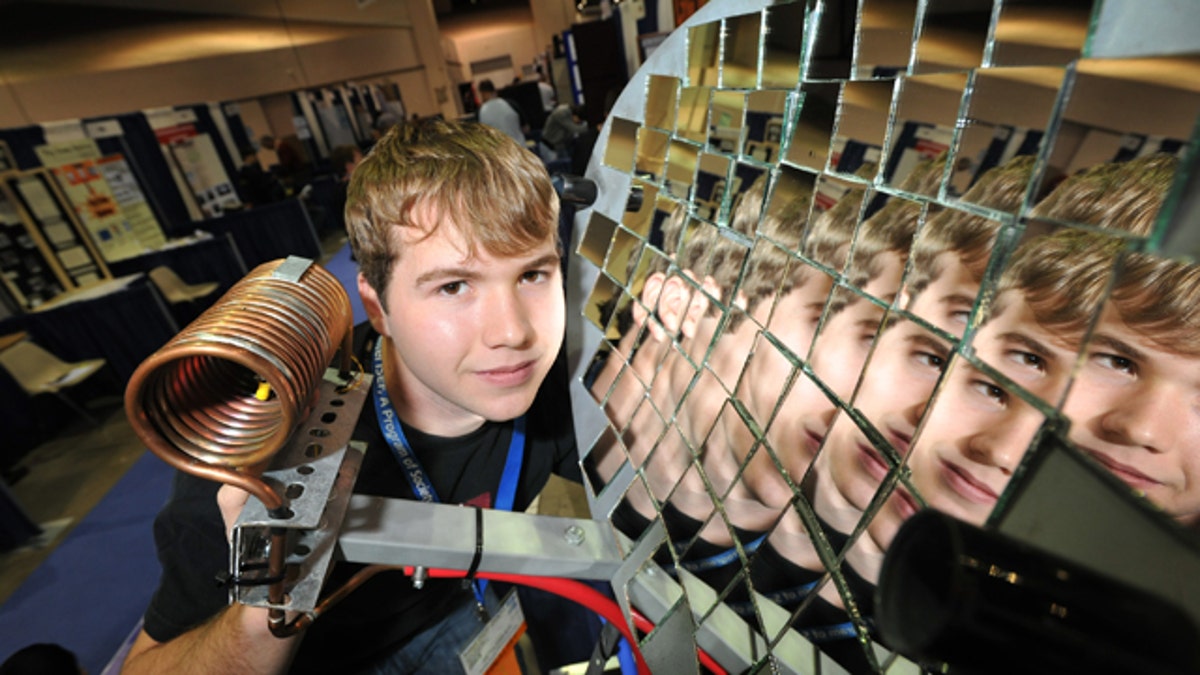
May 16, 2011: Seth Fisher, 16, from Bernville, Pa., demonstrates his solar heat concentrator at the Intel International Science and Engineering Fair, the world’s largest pre-college science competition, in Reno, Nev. (Intel)
Science projects ain't what they used to be.
Forget the potato clock and papier-mache volcano. Although these days, many entrepreneurial whiz kids immediately take their ideas to market on the Internet, millions of the nation's brightest -- and youngest -- minds are still hitting the fairs, winning up to $100,000 and even securing government contracts for astounding ideas that are far removed from those silly projects.
From "smart rockets" to LEGO robots, and plastic-eating microbes to nuclear detectors, here are nine recent science fair winners that’ll make you say "wow."
1. Better Space Travel. Most 18-year-olds are busy planning their collegiate track. Erika DeBenedictis of Albuquerqe, N.M., is busy writing software that helps spacecraft travel more efficiently in the cold vacuum that exists off-planet.
Her home-brew navigational system identifies "easy transit routes" in the solar system that help spacecraft move faster and use less fuel while dodging planets and avoiding gravitational pull. For her discovery, she netted $100,000 in prize money from the Intel Foundation, not to mention tenure on just about any NASA job she wants.
2. Plastic waste is a pain. It takes a really long time to decompose -- hundreds of years by some estimates. That didn’t stop 16-year-old Daniel Burd from trying to speed up the process. In 2008, Burd made international headlines by discovering a plastic eating microbe -- the plastic eating microbe -- that gets rid of the stuff.
Despite a healthy number of rocket scientists in the world, Burd was the first person to find these key critters. By concentrating the bacteria in his science fair project (which won the Canada-Wide Science Fair), he was able to increase degradation by more than 40%.
3. Who needs Google? If you’ll remember, Google has the lock on text-based search results. But visual search results (that actually work) remain to be perfected. Which makes David Liu’s work to develop a system that can recognize and understand digital images all the more interesting.
Liu’s work is so advanced, in fact, his software is already monitoring satellite images to identify real-time hazards such as fire, enabling unmanned aircraft and making web searches better.
SCIENCE FAIR PROJECT IDEAS
* Science Made Simple -- Science fair projects and ideas.
* The Discovery Channel -- Science fair central at the Discovery channel has tons of ideas.
* Science Buddies -- a monster compendium of science fair ideas.
* Science Club -- Scienceclub.org's list of advanced projects are bound to inspire.
4. LEGOs, on another level. When I play with LEGOs, I build really cool forts and tanks for my kids. When Anna Simpson plays with LEGOs, she builds a chemical-detecting robot capable of sniffing out hazards (like the toxic sludge plaguing Hungary) so humans don’t have to.
And she won the California State Science Fair in the process.
Although only 6 inches long, Simpson’s chip-enabled LEGO prototype could have a big impact when applied to industry, security, counter-terrorism, environmental and even Mars exploration.
5. How to get a faster PC, for free. In the information age, nothing is more annoying than a slow or otherwise unresponsive computer. Enter 18-year-old Kevin Ellis of Vancouver, Wash. Instead of throwing more hardware at the problem, Ellis is boosting computer performance by analyzing software programs while they run -- and then farming out their work across all the CPUs in a computer to make them run quicker.
Thanks to this clever project, we can hope for faster computers without having to buy more equipment -- a double win! As for Ellis, he won a cool $50,000 for the project -- plenty of funding for his computers.
6. Can light cure cancer? Cancer research has purportedly existed since 1600 B.C., when ahead-of-the-curve Egyptians first treated the disease surgically. Although there's still no cure, 18-year-old Amy Chyao of Richardson, Texas, is doing her part to get us all to the finish line.
With the help of photodynamic therapy, Chyao developed a process that uses light energy to assist the killing of cancer cells. For her work, she won the prestigious Intel International Science and Engineering Fair award this year.
7. A nuclear sniffer. Taylor Wilson should know a thing or two about nuclear weapons. After all, he lives in Nevada, where a large number of bombs have been dropped for testing purposes. But how this 16-year-old was able to "reliably detect" nuclear weapons and other explosive materials at such a young age, using a sweet-looking drive-through sensor, is beyond me.
In fact, Wilson started doing his research at the ripe age of 11. He was even awarded a grant from Homeland Security.
8. The deepest dive Climate research has so far proven to be a tough, controversial and highly political nut to crack. It’s also really expensive to research. Which makes Ryan Garner's and Amanda Wilson's "off the shelf" solution so appealing.
For less than $5,000, the pair built an underwater, camera-equipped rover to "meet the challenges of the harshest environments on Earth." Although still a prototype, the blue-collar solution is a breath of fresh air in a sea of madness; it's helped with practical climate research, letting University of California Santa Barbara researchers learn about the behavior of marine animals.
9. Snap, crackle, pop. Of course, it’s nice to recognize pragmatic science fair contestants as well. Like this little guy named Caleb. Obviously his "King of Pop" project won’t win any awards. But it does answer one of the most important questions of the last half century: Which microwavable popcorn brand pops best?
"The brand that cost the most was the brand that popped the most kernels," Caleb concluded. That is to say, Orville Redenbacher's. His research should give you something to chew on.
FoxNews.com's SciTech section is on Twitter! Follow us @fxnscitech.